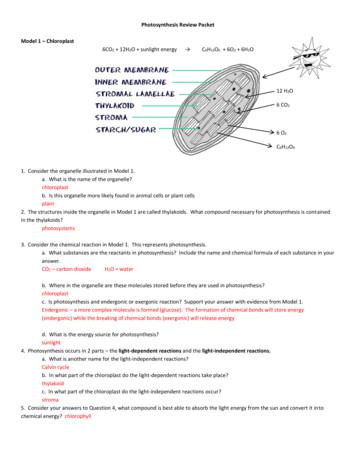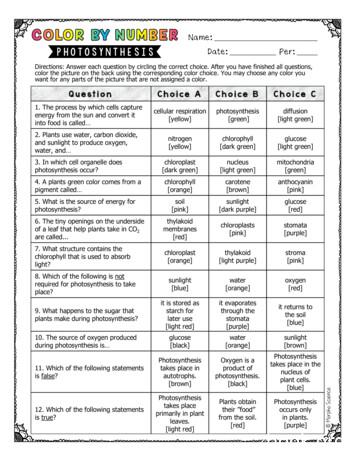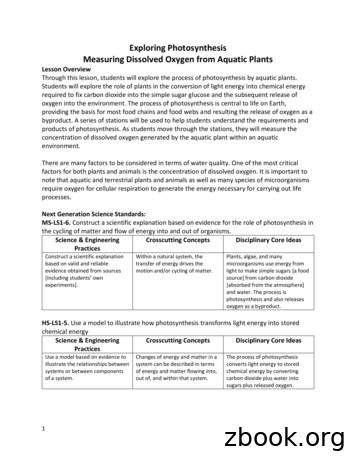Photosynthesis Review Packet Model 1 Chloroplast 6CO 12H .
Photosynthesis Review PacketModel 1 – Chloroplast6CO2 12H2O sunlight energy C6H12O6 6O2 6H2O12 H2O6 CO26 O2C6H12O61. Consider the organelle illustrated in Model 1.a. What is the name of the organelle?chloroplastb. Is this organelle more likely found in animal cells or plant cellsplant2. The structures inside the organelle in Model 1 are called thylakoids. What compound necessary for photosynthesis is containedin the thylakoids?photosystems3. Consider the chemical reaction in Model 1. This represents photosynthesis.a. What substances are the reactants in photosynthesis? Include the name and chemical formula of each substance in youranswer.CO2 – carbon dioxideH2O waterb. Where in the organelle are these molecules stored before they are used in photosynthesis?chloroplastc. Is photosynthesis and endergonic or exergonic reaction? Support your answer with evidence from Model 1.Endergonic – a more complex molecule is formed (glucose). The formation of chemical bonds will store energy(endergonic) while the breaking of chemical bonds (exergonic) will release energyd. What is the energy source for photosynthesis?sunlight4. Photosynthesis occurs in 2 parts – the light-dependent reactions and the light-independent reactions.a. What is another name for the light-independent reactions?Calvin cycleb. In what part of the chloroplast do the light-dependent reactions take place?thylakoidc. In what part of the chloroplast do the light-independent reactions occur?stroma5. Consider your answers to Question 4, what compound is best able to absorb the light energy from the sun and convert it intochemical energy? chlorophyll
6. What substances are produced during photosynthesis? Include the name and chemical formula of each substance in youranswer. C6H12O6 glucoseO2 oxygen7. Why is it necessary to have 6 CO2 entering the chloroplast?Glucose contains 6 carbons which are need to make glucose – which contains 6 carbonsModel 2 – The Light-Dependent reactionsBAaCbATP Synthase8. In Model 2, what shape or symbol represents a single electron?Small circle9. In the light-dependent reactions electrons are released from molecules in two ways.a. Find two places in Model 2 where electrons are released from chlorophyll by a photon of light coming from the sun.b. Find one place in Model 2 where electrons are released from water molecules.c. When the electrons are released from water molecules, what other products are formed?Oxygen gasThe light-dependent reactions of photosynthesis include three major processes:A. Excited electrons leave chlorophyll and reduce NADP into NADPH.B. Excited electrons moving through the electron transport chain provide the free energy needed to pump hydrogen ionsinto the inner thylakoid.C. Hydrogen ions flowing out of the thylakoid via a protein channel provide free energy needed to convert ADP to ATP.10. In Model 2, label the diagram with A, B and C to indicate where the three steps above are occurring.11. The light-dependent reactions include an electron transport chain system. Briefly describe how this system works and what jobit performs in the light-independent reactions.The electron transport chain allows electrons to move from photosystem II to photosystem I. The movement of electrons providesthe energy necessary to pump additional H ions in to the thylakoid space. The H ions will pass through ATP synthase producing ATP.12. Refer to Model 2.a. Name the embedded protein complex found in the thylakoid membrane that uses excited electrons to reduce NADP into NADPH? NADP reductase
b. Name the embedded protein complex found in the thylakoid membrane that provides excited electrons to the electrontransport chain? Photosystem IIc. Name the embedded protein complex in the thylakoid membrane that converts ADP to ATP using free energy from aflow of hydrogen ions. ATP synthase13. Once a chlorophyll molecule has released electrons it is no longer useful until those electrons are replaced.a. According to Model 2, what is the source of replacement electrons for those released from photosystem I?photosystem IIb. According to Model 2, what is the source of replacement electrons for those lost from PSII?water14. Is carbon dioxide involved in the light reactions?no15. Refer to Model 2.a. Write a chemical reaction that summarizes all of the chemical reactions in the light-dependent reactions ofphotosynthesis starting with two water molecules.2H2O ----------- 2H 2e- O2NADP 2e 2H ----------- NADPH H ADP P --------- ATPb. In the photosynthesis reaction in Model 1, twelve water molecules are shown as reactants, but six water molecules areshown as products. Are any of the twelve water molecule products of the light-dependent reactions?noc. Calculate the total number of oxygen, NADPH and ATP molecules that are produced when 12 water molecules completethe light-dependent reactions.12 O26 NADPH9 ATP16. Where do the ATP and NADPH produced during the light-reactions go when the process is complete?The molecules are used in the Calvin cycleModel 3 – The Light Independent Reactions (Calvin Cycle) For these questions – 1 turn 3 spins17. According to Model 3, what are the three phases of the Calvin cycle? Carbon fixation, reduction and regeneration of RuBP
18. Find the compound ribulose biphosphate (RuBP) in Model 3.a. How many RuBP molecules are used in one turn of the Calvin cycle?3b. How many carbon atoms are in each RuBP molecule?5c. Calculate the total number of carbon atoms represented in all of the RuBP molecules used in one turn of the Calvin cycle.1519. RuBP combines with carbon dioxide to form phosphoglycerate (PGA) during the carbon fixation phase of the Calvin cycle.a. How many CO2 molecules are used in one turn of the Calvin cycle?3b. How many PGA molecules are made in one turn of the Calvin cycle?6c. How many carbon atoms are in each PGA molecule?3d. Calculate the total number of carbon atoms represented in all of the PGA molecules used in one turn of the Calvin cycle?1820. Explain what happened to the carbon atom from the carbon dioxide molecule that entered the Calvin cycle.The carbon in carbon dioxide will “become” the carbon found in G3PModel 3 is a simplified version of the Calvin cycle. Each of the three phases in the cycle consist of multiple reactions thatare catalyzed by enzymes specific to that reaction. These enzymes have names like RuBisCo, phosphoglycerate kinaseand PGAL hydrogenase.21. Refer to the reduction phase of the Calvin cycle in Model 3.a. What molecule does the PGA molecule turn into during this phase of the Calvin cycle?G3Pb. Describe specifically how the structures of the two molecules in part a are different.G3P contains more H atoms that PGAc. Identify the types and numbers of molecules that provide the free energy necessary for the reduction of the PGAmolecules.ATP (provides the energy) and NADPH (provides electrons and H for the reduction)d. Is the total number of carbon atoms present in the Calvin cycle changed during the reduction phase? Support youranswer with evidence from Model 3.No the number remains the same – no carbon atoms sare removed during the reduction phase22. Water is a product of the reduction phase of the Calvin cycle.a. How many water molecules are produced?6b. Explain where the hydrogen and oxygen atoms in these water molecules originated.The H atoms are carried along with the NADPH (NADPH H ) and the O atoms come from Carbon dioxide – CO2 has moreoxygen that is needed to produce glucose,23. Refer to the regeneration phase of the Calvin cycle in Model 3.
a. How many G3p molecules continue on to the regeneration phase of the Calvin cycle?5b. Identify the types and numbers of molecules that provide free energy necessary for the regeneration of these molecules.ATPc. How many total carbon atoms remain in the Calvin cycle at this point?15d. What molecules are “regenerated” in this phase of the cycle?3e. How many total carbon atoms leave the Calvin cycle before the regeneration phase?3f. What happens to the G3P molecule that does not continue on in the Calvin cycle?It will be used to make more complex sugars (glucose, etc)24. The reaction in Model 1 shows glucose as a product of photosynthesis.a. How many G3P molecules will it take to make one molecule of glucose? Justify your answer with a discussion ofnumbers of carbon atoms.2 G3P contains 3 carbons and glucose contains 6 carbon atomsb. How many turns of the Calvin cycle will it take to make one molecule of glucose?2c. Calculate the total number of ATP and NADPH molecules used in the production of one molecule of glucose.9 ATP and 6 NADPH25. Where do the ADP and NADP go after they are used in the Calvin cycle?Returned to the light reactions26. Explain in detail, how the two reactions depend on each other.The light reactions produce ATP and NADPH needed in the Calvin cycle, and the ADP and NADP produced in the Calvincycle are returned to the light reactions to be recycled into ATP and NADPH27. Under each molecule in the equation below, indicate whether it is involved in the light-dependent reactions or the Calvin cycle6CO2 12H2O sunlight energy C6H12O6 6O2 6H2OCalvinLightCalvinLightCalvinModel 4 – The Study of PhotosynthesisOxygenConcentrationof moleculesRuBPCarbon dioxideTime
28. When algae are undergoing photosynthesis, the concentration of various molecules change within the cells. Theseconcentrations can be monitored and graphed. Explain the shape of each line on the graph in Model 4.Oxygen is constantly being produced in the light reactions because water is being splitCarbon dioxide levels decrease because it is used in the Calvin cycleRuBP remains somewhat constant because it is regenerated in the Calvin cycle29. Photosynthesis is typically represented by a simple equation.CO2 6H2O lightC6H12O6 6O2a. Compare and contrast this simplified equation with the one presented in Model 1.This equation only takes into account the water used in the light reactions and not the water produced in the Calvin cycleb. Using the information from this activity explain why the equation is a vastly oversimplified representation of the actual process.There are many reactions that happen along the way to complete the formation of glucoseSplitting of waterReduction of NADPHProduction of ATP
d. What is the energy source for photosynthesis? sunlight 4. Photosynthesis occurs in 2 parts – the light-dependent reactions and the light-independent reactions. a. What is another name for the light-independent reactions? Calvin cycle b. In what part of the chloroplast do the li
Photosynthesis takes place in autotrophs. [brown] Oxygen is a product of photosynthesis. [black] Photosynthesis takes place in the nucleus of plantcells. [blue] 12. Which of the followingstatements is true? Photosynthesis takes place primarily in plant leaves. [light red] Plants obtain their ”food” from the soil. [red] Photosynthesis .
photosynthesis 1/2-5/2 8/2 S1-5 Picnic Day 9/2-19/2 Lunar New Year Holiday photosynthesis 11A 4/6 Chapter 21 Photosynthesis o Basic concepts of photosynthesis o Requirements for photosynthesis o Site of The process of photosynthesis oPre Lesson Worksheet o Communication s
Photosynthesis Chapter 8 2 Photosynthesis Overview Energy for all life on Earth ultimately comes from photosynthesis. 6CO 2 12H 2O C 6H 12O 6 6H 2O 6O 2 Oxygenic photosynthesis is carried out by: cyanobacteria, 7 groups of algae, all land plants 3 Photosynthesis Overview Photosynt
Review: Differences between Photosynthesis and Cellular Respiration Summary Photosynthesis and Cellular Respiration 2 Review: Similarities between Photosynthesis and Cellular Respiration Both photosynthesis and cellular respiration
UNIT 1 PHOTOSYNTHESIS AND RESPIRATION Photosynthesis is the process whereby plants use carbon dioxide, water and light energy in a series of chemical reactions to produce glucose (food). Photosynthesis Microorganisms Interactions and interdependencies Life and living Photosynthesis and respiration Photosynthesis Respiration
photosynthesis of an aquatic plant [Elodea]. The rate of photosynthesis can be determined by measuring the concentration of dissolved oxygen as the plant undergoes photosynthesis. There are multiple methods for measuring the rate of photosynthesis including: The uptake of CO 2 The production and release of O 2
In this live Gr 11 Life Sciences show we take a look at Photosynthesis. In this lesson we study the process of photosynthesis looking at the light and dark phases. We discuss the importance of photosynthesis as well as consider the effects of varying amou nts of light, carbon dioxide and temperature on the rate of photosynthesis.
LAB 8 – Photosynthesis . Objectives. 1. Assess CO 2 consumption and O 2 production during photosynthesis. 2. Analyze the role of light in photosynthesis. 3. Examine the effect of different wavelengths of visible light on photosynthesis. Introduction . In order to , organisms require a source of























